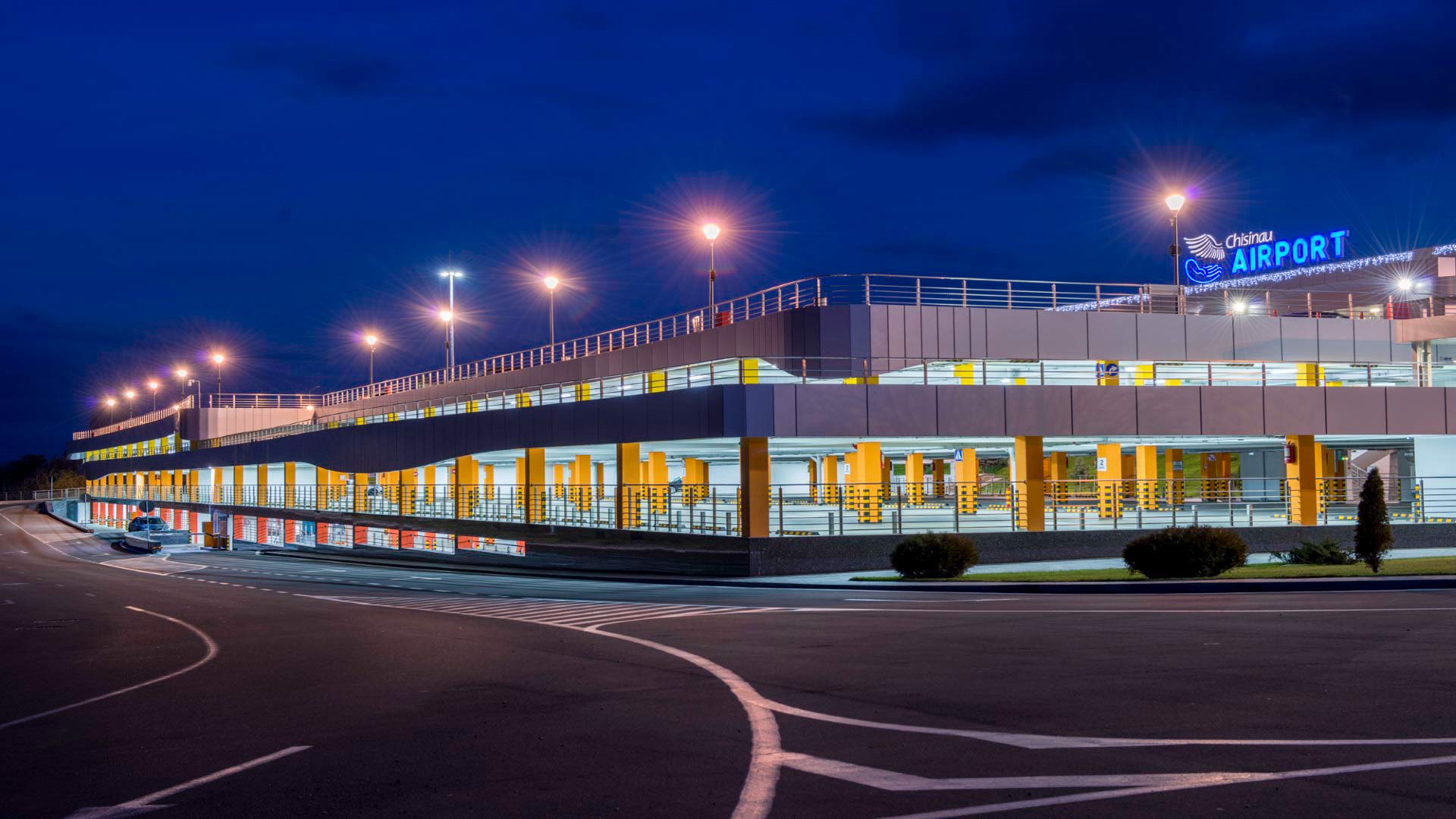Case Study: International Airport “Eugen Doga” Chişinău
Sustainable growth, innovations, new carriers and regional hub ambitions

Interview by Nikodem Szczygłowski, CONNECT Aviation Consultant
International Airport “Eugen Doga” Chişinău– the capital and so far the only international airport in Moldova – is definitely an interesting case study for aviation development during last vulnerable years in the Central and Eastern Europe, affected by the COVID-19 pandemic and then immediately in the Russian military aggression in Ukraine, that has influenced multiple changes within the industry of the region. The IATA code for InternationalAirport “Eugen Doga” Chişinău was officially changed from KIV to RMO on January 18, 2024.

The new code, RMO, stands for “Republic of Moldova” and was implemented to distance the airport from its Sovietera Russian name (Kishinev) andalign it with a distinct national identity. But that was far from the only change that happened there. Airport has significantly change both airlines and destinations structure during last 5 years and has managed to almost double passengers’ figures – from 2,308,715 passengers in 2022 to 5,151,000 in 2025 – with the airport expected to reach nearly 6 million passengers by the end of the year. The number of flights is also projected to increase by 30%, from 20,200 in 2022 to 34,049 in 2025.” Ms. Victoria Nanu, Chief Marketing & International Relations, International Airport “Eugen Doga” Chisinau, kindly agreed to answer some questions explaining the phenomenon of RMO airport, describing how airport managed to attract new carriers, completely changing the pre-pandemic market share and building up a network of new destinations, exclusively for CONNECT.

Q: International Airport “Eugen Doga” Chişinău has recently changed not only its IATA code – from KIV to RMO – but also a lot of things have been happening there in recent years. The withdrawal of Wizzair, Air Moldova leaving the market, Wizzair’s grand return with even greater momentum and a large number of routes, SkyUP’s base with its own flight program – all this testifies to the great potential of Moldova’s capital airport in the current reality. What else is contributing to the growing interest of carriers and the wider geography of connections?
Before the pandemic, Moldova’s air connectivity depended largely on two main carriers – Air Moldova and Wizz Air – which together transported more than 64% of all passengers at International Airport “Eugen Doga” Chişinău. However, 2023 became a real turning point. Air Moldova, our national carrier, ceased operations due to financial difficulties, Wizz Air suspended its base because of regional security concerns (the War in Ukraine), and flights to Russia – which previously accounted for almost 30% of total traffic – were completely suspended as Moldova joined international sanctions. These developments created a significant connectivity gap for the country.
To address this challenge, airlines such as FlyOne, HiSky, and Turkish Airlines quickly expanded their presence, yet we recognized that a broader strategic approach was needed.
We therefore optimised airport charges and introduced an attractive Airline Incentive Policy, offering financial and marketing support for new airlines, new routes, and capacity increases. This policy proved very effective in stimulating traffic and encouraging carriers to explore new destinations from Chişinău.
The results have been impressive. The number of operating airlines grew from 23 in 2023 to 33 in 2025, while the route network expanded from 42 to over 60 destinations. Passenger traffic increased by 46% year-on-year, reaching a historic record of 5 million travellers in October 2025.
Importantly, we also succeeded in bringing back around 30% of Moldovan passengers who had previously chosen nearby foreign airports. This recovery was driven by stronger connectivity, a wider choice of destinations, and a balanced air travel offer from low-cost to full-service carriers.

Q: Considering the example of the aforementioned SkyUP – originally a Ukrainian carrier which, in the context of the ongoing war in Ukraine, which prevents civil flights, is looking for other development options, including in Moldova – how important is the proximity of Ukraine for your airport?
The airport’s strategic proximity to southern Ukraine has turned Chişinău into a convenient regional gateway, attracting both Ukrainian travellers and carriers such as SkyUp. Since the closure of Ukrainian airspace in 2022, many passengers from the Odessa region and surrounding areas have chosen Chişinău as their primary departure point for international travel.
Today, passengers from Ukraine account for approximately 25-27% of total traffic – a figure that has remained remarkably stable over the past two years. This consistent
flow highlights the airport’s growing importance as an alternative hub for Ukrainian travellers seeking reliable air connections to Europe and beyond.
In April 2025, SkyUp commenced scheduled operations from Chişinău, deploying three Boeing 737 aircraft to serve a range of European destinations. This expansion formed part of a broader strategy to restore regular flights to popular cities across Europe and to meet the high demand from Ukrainian travellers, further underlining the airport’s regional significance.
By June 2025, SkyUp had launched 11 routes from Chişinău, including Lisbon, Paris Beauvais, Larnaca, Barcelona, Heraklion, Alicante, Athens, Corfu, Thessaloniki, Nice, and Palma de Mallorca. This rapid expansion positioned SkyUp as the third-largest carrier at Chişinău International Airport Eugen Doga, according to the September 2025 results, following FlyOne and Wizz Air, reinforcing the airport’s role as a key hub in the region.

Q: How does the airport address flight safety issues, which is undoubtedly a very important factor at present?
Flight safety represents the highest operational priority at International Airport “Eugen Doga” Chişinău. As the aerodrome operator, we maintain a Safety Management System (SMS) fully aligned with national regulations, EASA documentation, and ICAO Annex 19 requirements. Our approach integrates systematic data collection and monitoring of both leading and lagging safety indicators, allowing us to identify, assess, and mitigate risks proactively across all areas of airport operations. We operate both mandatory and voluntary reporting systems that encourage all personnel and partners to report hazards and occurrences without fear of reprisal. The collected reports are analysed in detail, and the resulting safety data are used to identify trends, determine root causes, and implement corrective and preventive measures. This data-driven foundation supports our continuous improvement cycle, complemented by regular safety audits, inspections, and emergency preparedness exercises.
All operational changes are governed by formal Management of Change (MOC) procedures to ensure that potential risks associated with infrastructure, personnel, or procedural modifications are properly evaluated and controlled before implementation. Wildlife management also remains a key component of our safety program. Our Wildlife Hazard Management (WHM) system includes continuous monitoring, deterrence measures, and habitat management, supported by a comprehensive risk assessment conducted recently for all bird and animal species present on the aerodrome. Safety communication is maintained through the regular issuance of Safety Bulletins, Safety Information Notices, Recommendations, and Operational Directives, ensuring that all stakeholders remain informed and aligned with current operational risks and mitigation strategies.
In addition to our internal processes, we work in close cooperation with the Civil Aviation Authority, Air Traffic Services (MOLDATSA), and all ground handling agents to ensure strict compliance with aerodrome safety regulations and operational standards. Thanks to these coordinated control measures, despite the considerable increase in the number of operations at the aerodrome, we have successfully avoided incidents that could have caused damage to aircraft.
This collaborative safety culture – supported by ongoing staff training, transparent communication, and continuous investment in modern infrastructure – ensures that safety remains an integral part of every activity conducted on the aerodrome.

Q: What are the current priorities for the development of International Airport “Eugen Doga” Chişinău ?
Our main priority now is to ensure sustainable growth and to strengthen the airport’s position as a leading regional hub. To achieve this, we are focusing on several key areas.
Our development priorities are focused on sustainable growth, innovation, and passenger experience. In the short term, our main goal is to complete the terminal expansion project, which adds 4,500 square metres of space, optimises passenger flow, and improves comfort and service quality throughout the airport journey. At the same time, we continue to expand airline partnerships and the route network, diversify the air travel offer, and enhance regional connectivity by working closely with both existing and new carriers.
Expanding our route network to major European and Middle Eastern destinations remains one of the top priorities.
Parallel to this, we are investing in digitalisation and automation, including smart security systems and AI-driven tools for passenger flow management. Finally, we are planning to integrate eco-friendly technologies such as electric ground vehicles and solar power plants, aligning our operations with European sustainability standards.
In short, our vision is to make RMO not only Moldova’s gateway to the world but also a modern, efficient, and sustainable airport serving as a bridge between Eastern Europe and the wider global aviation network.















